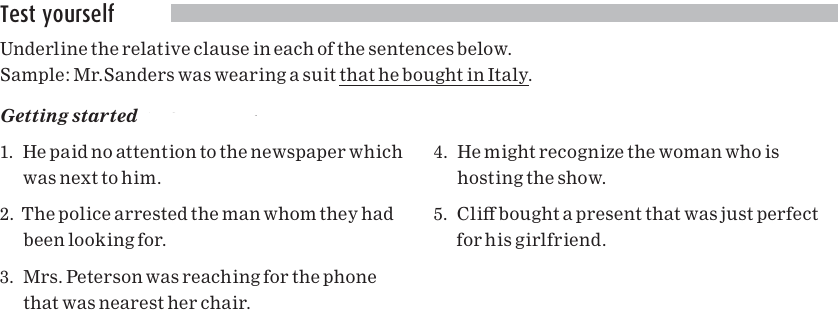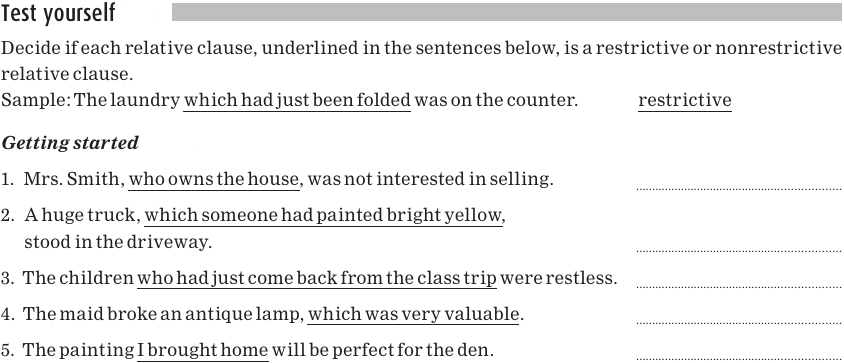Sentences with relative clauses
A well-known children’s story starts with the line, This is the house that Jack built. It continues,
This is the malt that lay in the house that Jack built. This is the rat that ate the malt that lay in the house that Jack built. The story continues until it ends with the following sentence: This is the farmer sowing his corn, that kept the cock that crowed in the morn, that waked the priest all shaven and shorn, that married the man all tattered and torn, that kissed the maiden all forlorn, that milked the cow with the crumpled horn, that tossed the dog, that worried the cat, that killed the rat, that ate the malt that lay in the house that Jack built.
This story gives us a good demonstration of complex sentences with relative clauses, which are a kind of dependent clause. For example, in the sentence This is the house that Jack built, the main clause is This is the house, and the dependent, relative clause is that Jack built. The relative clause acts as an adjective: it modifies the noun phrase the house, telling us more about it. This is why relative clauses are also referred to as adjective clauses.
Quick tip
A relative clause (adjective clause) is a kind of dependent clause; it provides additional information about a noun phrase in the main clause. Example (relative clause underlined):
I brought the cookies that are on the plate.
In each sentence below, the relative clause is underlined, and the noun phrase which the relative clause is modifying is in bold. The main clause can stand on its own as a sentence without the relative clause; the relative clause just provides additional information about the noun phrase it’s modifying and cannot stand alone. Like other clauses, a relative clause has its own subject and verb phrase.
1. She transferred the plate to the tray that she just washed.
2. Blanche thought about the man who was living in Italy at the time.
3. He called the company that usually supplies the pipes.

Answers

The relative clause doesn’t necessarily follow the main sentence (clause); it can also be within the main sentence. In the following sentences, the relative clause is underlined and the main sentence (clause) is in bold. In sentences 4 and 5, the relative clause follows the main clause; in sentences 6 and 7, it’s inside the main clause.
4. I’ve brought the horse which has been specially trained.
5. We tipped the waiter who had served us so well.
6. The man who was living in Italy at the time knew all the facts.
7. The company that usually supplies the pipes has gone out of business.
Again, if the relative clause (the underlined part) is removed, the main clause can still stand on its own as a sentence.

Answers

We’ve seen (in Complex sentences) that other dependent clauses are linked to the rest of the sentence by subordinating conjunctions. The same is true of relative clauses. Those subordinating conjunctions which link relative clauses to the rest of the sentence are called relative pronouns, and you may remember that we talked about them earlier. The relative pronoun which introduces the relative clause is underlined in the sentences below:
8. I just read a book which had a really exciting ending.
9. The soldier whom I’m writing to recently came home on leave.
10. She signed a deal with the publishing company that gave her the best offer.
Note that words that are relative pronouns can also be used in other ways. For example, who can be used as a relative pronoun, but it can also be used as a question word, as in the sentence, Who married her?
Quick tip
Relative clauses begin with one of the relative pronouns: that, which, who, whom, whose.

Answers

Just as a sentence can have more than one dependent clause, it can have more than one relative clause. We saw this earlier, in the sentences about Jack, and see it here as well:
11. Pablo married the woman whose sister lived in a house which was next door to the one that I bought from the man who had first built it.
Even though this sentence is very long and contains four relative clauses, it is still perfectly grammatical.

Answers

You may be wondering why relative pronouns are called pronouns. You know that pronouns replace noun phrases in a sentence. All of the relative pronouns except whose do the same thing.
Quick tip
A relative pronoun connects the relative clause to the rest of the sentence. All of the relative pronouns (except whose) also replace a noun phrase in the relative clause. (Whose replaces a determiner.)
Let’s review how the last Quick tip works in the following sentence, whose relative clause is underlined:
12. Blanche thought about the man who was living in Italy.
What noun phrase is the relative pronoun who replacing? The who refers to the noun phrase the man.
Here’s another example:
13. He called the company that usually supplied the pipes.
In this case, what does the relative pronoun that replace? It replaces the noun phrase the company.

Answers


Answers

Let’s take a look at the following sentence:
14. The man whom I interviewed was not very knowledgeable.
As we discussed above, the sentence contains a relative clause, whom I interviewed, which begins with the relative pronoun whom. Will this sentence still be grammatical if the relative pronoun, whom, is left out?
15. The man I interviewed was not very knowledgeable.
If you think this sentence sounds fine, you’re absolutely right. Here are some more examples:
16a. The permit that the builders applied for was denied.
16b. The permit the builders applied for was denied.
17a. The celebrity who Jack photographed left the theater early.
17b. The celebrity Jack photographed left the theater early.
You will notice that when the relative pronoun is omitted, as in sentences 15, 16b, and 17b, one noun phrase is directly followed by another noun phrase: the man + I in sentence 15, the permit + the builders in sentence 16b, and the celebrity + Jack in sentence17b. So if you see a sentence that has two noun phrases next to each other, check to see if the sentence would still be grammatical and mean the same thing if you put a relative pronoun between the two noun phrases; this will help you identify relative clauses.
Quick tip
A relative pronoun may be omitted before a noun phrase. Example: The movie (that) I saw was exciting.

Answers

When we look at relative clauses more closely, we find that there are actually two types: restrictive relative clauses and nonrestrictive relative clauses. Compare the following sentences; the relative clauses are underlined.
18. Bridget likes doughnuts that have chocolate frosting.
19. She likes Peter Bolton, who is her son’s piano teacher.
In sentence18, the relative clause that have chocolate frosting is telling us exactly which doughnuts Bridget really likes. The clause is telling us that Bridget doesn’t necessarily like all doughnuts; she specifically likes those that have chocolate frosting. This kind of relative clause, which limits or restricts the noun phrase it’s modifying, is called a restrictive relative clause.
In contrast, in sentence19, the relative clause who is her son’s piano teacher is telling us something about Peter Bolton, but if we omit this relative clause, we still know who Peter is, although we don’t know the extra information that he is her son’s piano teacher.
This type of relative clause is called a non-restrictive relative clause. It’s always separated from the main sentence by commas. (You can think of it as being separated from the main clause by commas because it’s not essential.) When we say a sentence with a non-restrictive relative clause, we usually pause at the commas separating it from the main sentence.
Here are some more examples to help clarify the difference between restrictive and non-restrictive relative clauses:
20. The employees who were upset came to the meeting.
21. The employees, who were upset, came to the meeting.
What’s the difference in meaning between these two sentences? According to sentence20, only those employees who were upset came to the meeting. The other employees didn’t come to the meeting. That is, sentence20 restricts the employees who came to the meeting to only those who were upset. Sentence20 thus contains a restrictive relative clause.
Again, notice that in sentence21 the relative clause is separated from the main clause by commas. Sentence21 is also said with pauses where the commas are.
Note that one can always remove are lative clause, of either type, and still end up with a grammatical sentence. However, if the restrictive relative clause is removed, some of the information needed to fully identify the noun phrase we’re talking about is missing.
Quick tip
A restrictive relative clause limits the noun phrase which it is modifying; a nonrestrictive relative clause does not. A nonrestrictive relative clause is separated from the main clause by pauses, and, when written, it is separated from the main clause by commas. Examples: The dogs which were friendly were being trained as Seeing Eye dogs (restrictive). The dogs, which were friendly, were being trained as Seeing Eye dogs (nonrestrictive).

Answers


Answers

To enhance your understanding
Proper names are not modified by restrictive relative clauses. Here is an example:
22a. George, who is an architect, is a good friend of mine. (nonrestrictive)
22b. *George who is an architect is a good friend of mine. (restrictive)
Since the identity of a proper noun is already well defined, it makes sense that restrictive relative clauses do not modify proper nouns.
Notice that if we want to be very specific about a proper name, to differentiate it from others with the same name, then using are strictive relative clause is entirely appropriate:
23. The George who is an architect is a good friend of mine. (restrictive)
24. The France that I am familiar with is a very lovely country. (restrictive)
To further enhance your understanding
A relative clause can modify any noun phrase in a sentence, whether that noun phrase is functioning as a subject, direct object, indirect object, or object of a preposition. For example, in sentence25, the relative clause refers to the direct object of the main clause:
25.My sister likes the house which has a large swimming pool.
And in sentence26, the relative clause refers to the indirect object of the main clause:
26.My sister sold the house to a family that has three children.
 الاكثر قراءة في Grammar
الاكثر قراءة في Grammar
 اخر الاخبار
اخر الاخبار
اخبار العتبة العباسية المقدسة


